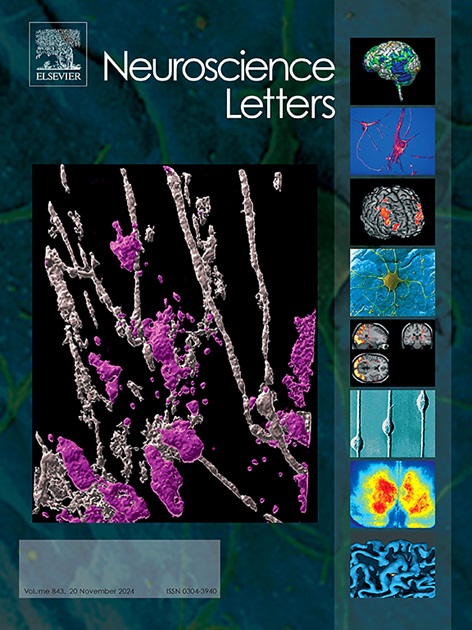Task-state hemodynamic responses correlate with consciousness levels and outcomes of patients with disorders of consciousness
IF 2
4区 医学
Q3 NEUROSCIENCES
引用次数: 0
Abstract
Background
Functional near-infrared spectroscopy (fNIRS) has emerged as a valuable tool for detecting brain functional activities. Motor imagery (MI) tasks have been employed to evoke brain responses in patients with disorders of consciousness (DOC), providing potential insights into their consciousness levels. However, the utility of brain functional characteristics for patient diagnosis and prognosis remains unclear.
Objective
This study aims to use fNIRS to investigate the characteristics of brain functional activities evoked by MI task in populations with varying levels of consciousness, and to explore the potential of these characteristics in the diagnosis and prognosis of DOC.
Methods
fNIRS was used to measure hemodynamic responses during MI tasks in a cohort of 63 DOC patients (26 vegetative states [VS] and 37 minimally conscious states [MCS]) and 70 healthy controls (HC). The mean values of hemodynamic responses in each brain region were extracted for inter-group and intra-group comparisons. Additionally, the correlation between hemodynamic responses and prognosis of DOC patients was investigated.
Results
Inter-group comparisons revealed that HC had significantly higher hemodynamic responses than both the MCS and VS groups across all brain regions. The MCS group demonstrated significantly higher responses than the VS group in the left premotor cortex, left primary motor cortex, right primary motor cortex, and left parietal cortex. In intra-group comparisons, 33 and 7 pairs of brain regions were significantly different in the HC and MCS group, while no significant differences were observed in the VS group. Furthermore, a significant correlation was found between the hemodynamic responses and the prognosis scores of DOC patients 6 months after the fNIRS examination.
Conclusions
Task-evoked functional activities in various brain regions among populations with varying levels of consciousness demonstrate significant intra-group and inter-group differences. The characteristics of brain functional activities provide valuable insights for the diagnosis and prognosis of DOC patients.
任务状态血流动力学反应与意识障碍患者的意识水平和预后相关
功能近红外光谱(fNIRS)已成为检测脑功能活动的一种有价值的工具。运动意象(MI)任务被用来唤起意识障碍(DOC)患者的大脑反应,为了解他们的意识水平提供了潜在的见解。然而,脑功能特征对患者诊断和预后的效用仍不清楚。目的利用近红外光谱(fNIRS)研究不同意识水平人群心肌梗死任务诱发的脑功能活动特征,并探讨这些特征在DOC诊断和预后中的潜在价值。方法采用近红外光谱(nirs)测量63例DOC患者(26例植物人状态[VS]和37例最低意识状态[MCS])和70例健康对照(HC)在心肌梗死任务期间的血流动力学反应。提取各脑区血流动力学反应的平均值,进行组间和组内比较。此外,研究血流动力学反应与DOC患者预后的相关性。结果组间比较显示,HC组所有脑区血流动力学反应均明显高于MCS组和VS组。MCS组在左侧运动前皮层、左侧初级运动皮层、右侧初级运动皮层和左侧顶叶皮层的反应显著高于VS组。在组内比较中,HC组和MCS组有33对和7对脑区存在显著差异,VS组无显著差异。此外,在fNIRS检查6个月后,血流动力学反应与预后评分之间存在显著相关性。结论不同意识水平人群的任务诱发各脑区功能活动存在显著的组内和组间差异。脑功能活动特征为DOC患者的诊断和预后提供了有价值的见解。
本文章由计算机程序翻译,如有差异,请以英文原文为准。
求助全文
约1分钟内获得全文
求助全文
来源期刊

Neuroscience Letters
医学-神经科学
CiteScore
5.20
自引率
0.00%
发文量
408
审稿时长
50 days
期刊介绍:
Neuroscience Letters is devoted to the rapid publication of short, high-quality papers of interest to the broad community of neuroscientists. Only papers which will make a significant addition to the literature in the field will be published. Papers in all areas of neuroscience - molecular, cellular, developmental, systems, behavioral and cognitive, as well as computational - will be considered for publication. Submission of laboratory investigations that shed light on disease mechanisms is encouraged. Special Issues, edited by Guest Editors to cover new and rapidly-moving areas, will include invited mini-reviews. Occasional mini-reviews in especially timely areas will be considered for publication, without invitation, outside of Special Issues; these un-solicited mini-reviews can be submitted without invitation but must be of very high quality. Clinical studies will also be published if they provide new information about organization or actions of the nervous system, or provide new insights into the neurobiology of disease. NSL does not publish case reports.
 求助内容:
求助内容: 应助结果提醒方式:
应助结果提醒方式:


